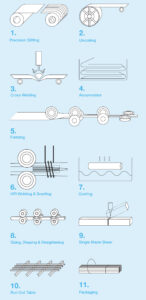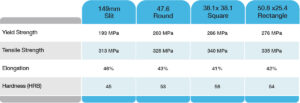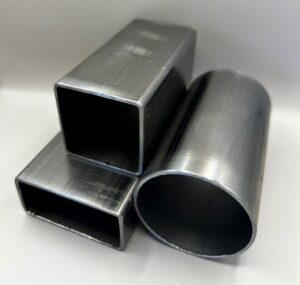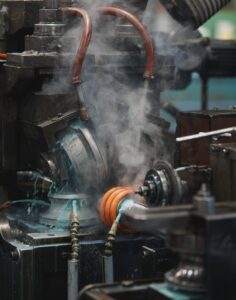How Cold Forming Alters Steel Tube Strength and Ductility
27 Mar 2025
During tube manufacture, steel strip is passed through a series of rollers in a process called cold forming. The rollers gradually shape the strip into a tube. This process includes several stages of forming and sizing, depending on the final tube dimensions. As the tube is formed, the mechanical properties of the steel strip undergo significant changes. Understanding these changes is essential for ensuring the tube meets the required strength, durability, and performance standards across various applications.
As the strip is progressively shaped into a tube, it experiences plastic deformation, leading to work hardening. This process alters key mechanical properties, including strength, hardness, and ductility, ultimately affecting the tube’s performance and characteristics.
Several other factors influence these property changes, including the input material (strip) composition, the number of forming and sizing stands, and the final tube profile.

(The tube making process)
As a result of cold forming, tensile strength increases slightly, while yield strength rises more significantly, leading to a higher yield ratio than the input material. Additionally, plastic deformation reduces the steel’s ability to stretch before fracturing, resulting in lower elongation values.
To illustrate these changes, we have recorded the mechanical properties of 149×1.6mm cold-rolled annealed strip before and after tube formation across three different profiles. Each of these profiles is made from the same strip width and therefore has the same weight and steel content. Testing was conducted in accordance with AS 1391:2020 (or ISO 6892-1:2019) using a Universal Grade 1 Testing Machine (UTM). Hardness testing uses the Rockwell B/HRB scale.

(The 50.8×25.4 test sample is taken from the 50.8mm side. The recorded mechanical properties are from a specific coil and mill run/s at a particular time and variations can occur. Some limitations can present in ‘coupon’ vs full length testing. If specific mechanical properties are required, we recommend ordering test results at time of order placement.)

(1.6×50.8×25.4, 1.6×38.1×38.1, 1.6×47.6 Precision Steel Tube)
The final key factor influencing the strength and integrity of the tube is the welding process. Our Precision Steel Tube is manufactured using a high-frequency induction (HFI) welding process, where a high-frequency current generates localised heating in a narrow heat-affected zone (HAZ). To ensure strong, high-quality welds, proper strip preparation, optimised welding parameters, and controlled in-line cooling are essential. Our process produces a weld zone that is at least as strong as the base material.

(High-frequency Induction Welding)
Cold forming plays a crucial role in shaping steel tubes, not only defining their dimensions but also significantly altering their mechanical properties. The increase in yield strength, changes in ductility, and overall work hardening effect must be carefully considered to ensure the final product meets performance expectations. Additionally, factors such as material composition, forming process parameters, and welding quality further influence the tube’s structural integrity.
At Industrial Tube Manufacturing, we combine proven and well established cold-forming techniques with high-frequency induction (HFI) welding to produce Precision Steel Tube that meets stringent quality standards. Our in-house capabilities, including custom milled lengths, cut to size options and 5-Axis Tube Laser cutting, allow us to provide tailored solutions to meet your specific needs.
For more information or to discuss your requirements, contact us today — let’s engineer the right solution for your application.